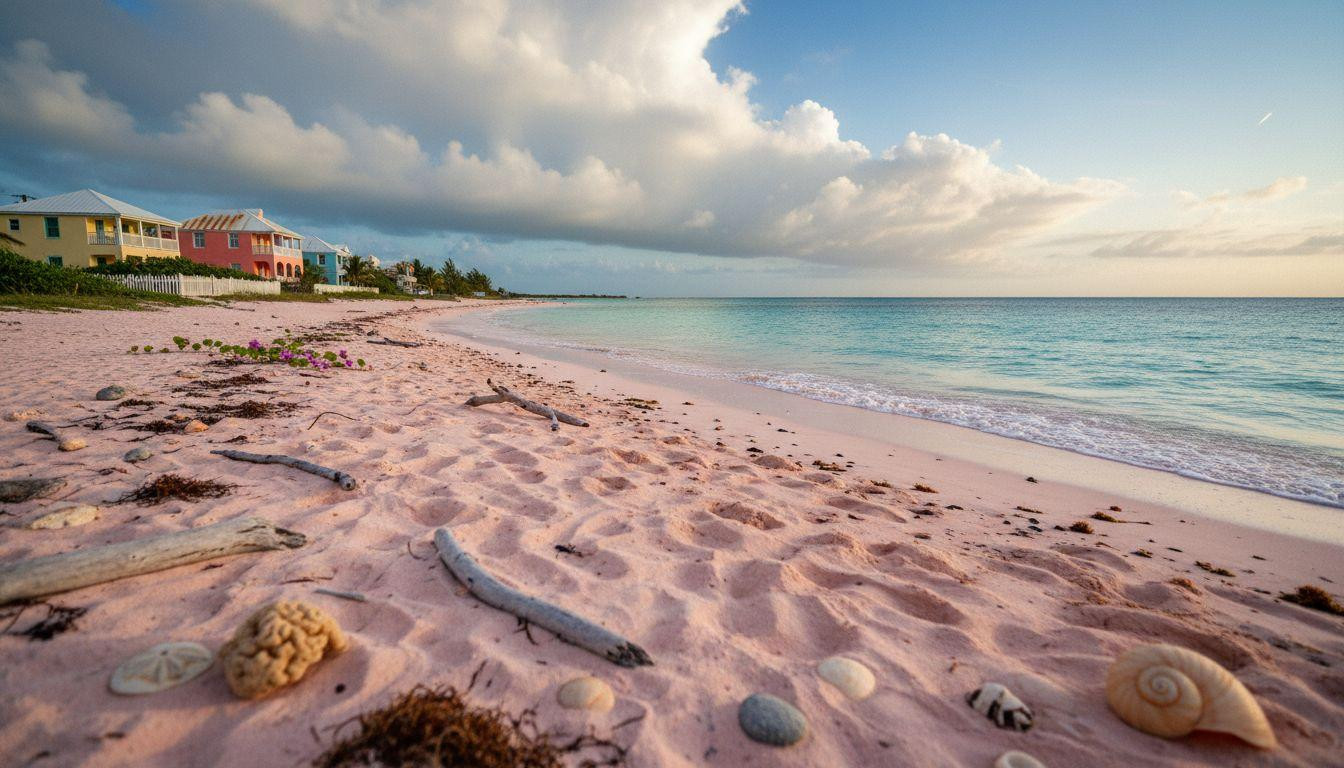Dawn breaks at 6:42 AM over Harbour Island’s eastern shore, where 3 miles of naturally pink sand catch first light like crushed rose petals scattered across turquoise Atlantic water. The color isn’t a filter or Instagram trick. It’s foraminifera, microscopic marine organisms mixing with white sand and coral fragments to create the Bahamas’ most impossible beach.
While 3.2 million tourists crowd Nassau’s cruise terminals 50 miles west, only 1,861 residents call this 3.5-mile island home. They’ve maintained something rarer than pink sand: authentic Caribbean rhythm unchanged since colonial times.
Where pink sand meets Atlantic blue at 25°30’N
Harbour Island floats 1.75 miles off Eleuthera’s eastern coast, suspended between tourist Bahamas and local truth. The 20-minute water taxi from North Eleuthera Airport costs $125 per person, effectively filtering crowds while keeping the island accessible from Miami in under 4 hours total travel time.
November temperatures hold steady at 72-82°F while Nassau swelters at 85°F. The beach stretches the island’s full eastern Atlantic side, 50-100 feet wide, with pink intensity shifting hourly as sunlight angle changes. Dunmore Town’s pastel colonial buildings cluster on the western harbor side, where golf carts replace cars on flower-lined streets.
The village (named for the 1786 British governor) feels more like 1760s England than 2025 Caribbean. Similar to small Greek islands that preserve authentic coastal culture, Harbour Island maintains its colonial charm through strict building codes and local pride.
The science behind the impossible pink
How foraminifera create natural rose tones
The pink comes from *Homotrema rubrum*, single-celled organisms with bright red shells living on reef undersides. Atlantic waves pulverize these microscopic skeletons, mixing red fragments with white calcium carbonate sand and coral pieces. The ratio creates soft blush that intensifies in golden hour light and after rainfall when sand moistens.
This isn’t marketing photography. It’s verifiable marine biology requiring specific conditions: healthy reefs, consistent wave action, and minimal human disruption. The Devil’s Backbone reef system (third-longest barrier reef globally) produces most foraminifera, creating a sustainable pink sand factory offshore.
Colonial architecture mirrors sand palette
Dunmore Town’s 18th-century buildings echo the beach’s color story deliberately. Pastel facades (coral pink, butter yellow, sky blue) weren’t chosen randomly by British colonial settlers. They mimicked Caribbean light quality, creating architecture that glows amber in sunset, just as the sand shifts from rose to copper as the sun drops toward the harbor at 5:35 PM.
Living the 1,861-resident reality
Beyond the beach: golf cart culture and reef access
No cars exist on Harbour Island by local law. Golf carts ($75-95 daily from Briland Carts) navigate streets too narrow for vehicles, passing chickens and locals who greet visitors by name after one day. The pace forces interaction, not resort isolation.
Devil’s Backbone reef snorkeling ($95 per person with Briland Adventures) reveals elkhorn coral and Nassau grouper thriving in protected waters. Horseback riding on pink sand ($65 for 45 minutes) happens at dawn before 82°F heat, hoofprints erasing in incoming tide. Like unexpected water phenomena near major cities, Harbour Island offers Caribbean authenticity within reach of US East Coast airports.
Conch salad and rum punch reality
Authentic Bahamian food survives here because tourists can’t overwhelm 20 streets. Conch salad with fresh citrus costs $18-25, not the $45 Nassau resort prices. Grilled snapper caught that morning runs $38-42 at family restaurants like Da Food Shack, where the owner’s family has served locals since the 1960s American tourism wave began.
Local rum punch isn’t watered-down tourist versions. It’s proper Nassau Royale mixed by bartenders whose grandparents poured drinks when small coastal communities maintained maritime traditions before mass tourism arrived.
The color that changes everything
Standing where pink sand meets turquoise water at sunrise, the science becomes poetry. Foraminifera skeletons (each smaller than a grain of salt) create a beach that looks Photoshopped but exists because of reef health, wave patterns, and geological luck spanning 5,000 years.
While Bermuda’s pink beaches draw 680,000+ annual visitors and Maldives’ white sands cost $500+ nightly, Harbour Island offers $150-250 accommodations and only 48,500 annual visitors. The pink isn’t just color. It’s evidence of an ecosystem functioning correctly, a small island maintaining balance between tourism and authenticity. November timing reveals authentic island life when crowds drop 60% from peak season.
Your Questions About Harbour Island’s Pink Sand Beach Answered
How do I actually get there and what does it cost?
Fly into Nassau International Airport, take a 25-minute domestic flight to North Eleuthera Airport ($95-125 per person with Bahamasair), then a 10-minute water taxi to Harbour Island. Total transfer time: 45 minutes from Nassau landing. Accommodation ranges $195-250 (The Landing, Coral Gardens Inn) to $875-1,150 (The Dunmore, Pink Sands Resort). November offers 25-35% lower prices than December-April peak season but maintains perfect 72-82°F weather.
Why is it pink and does the color fade?
The pink comes from red foraminifera shell fragments mixing with white sand. It’s permanent geology, not temporary algae blooms. Color intensity varies by sand moisture (deeper when wet), sun angle (strongest at 6:42 AM sunrise and 5:35 PM sunset), and recent wave action bringing fresh shell deposits. The beach has maintained its pink for centuries because healthy reefs continue producing foraminifera. Scientific monitoring confirms stable populations through 2025.
How does this compare to Bermuda or other pink beaches?
Bermuda’s pink beaches attract far more tourists (680,000+ annual visitors vs Harbour Island’s 48,500), with correspondingly higher prices and crowds. Harbour Island’s pink is softer rose versus Bermuda’s coral-pink, and the beach stretches longer (3 continuous miles vs Bermuda’s scattered coves). Bahamas location means warmer year-round water (75-82°F) compared to Bermuda’s 65-82°F range. You’re choosing between established tourism infrastructure and authentic island culture.
At 5:15 PM, the pink sand deepens to rose-gold as shadows lengthen across the beach. A lone golf cart putters down Bay Street where bougainvillea blooms against a butter-yellow colonial wall. The Atlantic whispers against 3 miles of impossible sand that 3.2 million Nassau tourists never find.
